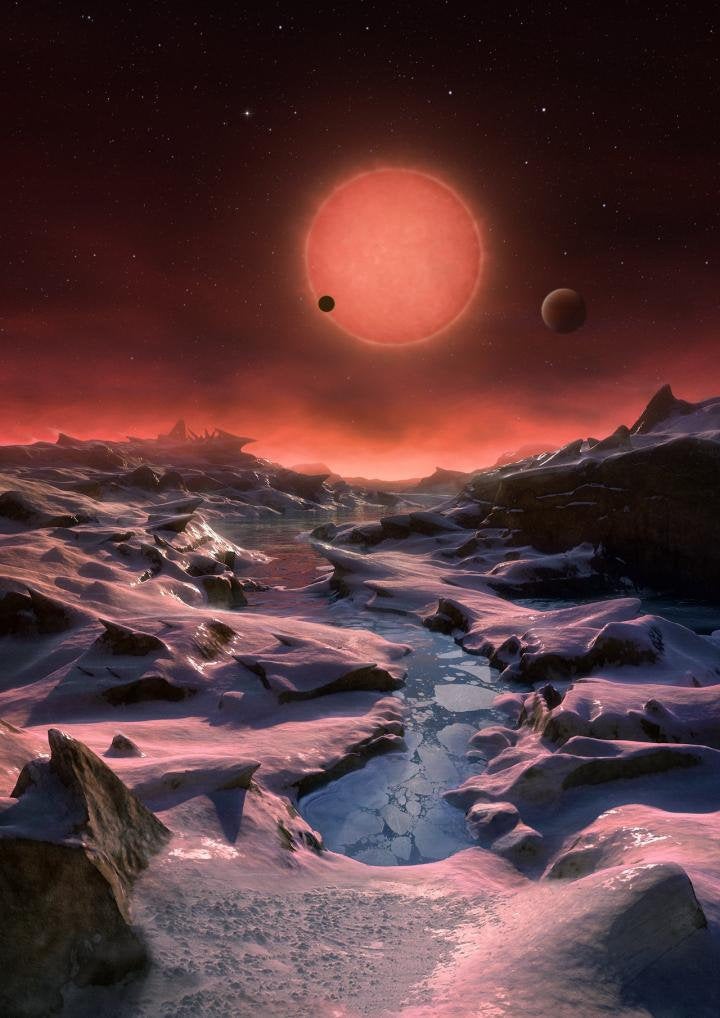Three habitable worlds orbiting around a nearby ultracool dwarf star could be the best bet of finding life on another planet.
The three Earth-like exoplanets "red worlds" are just 40 light years away from Earth.
The sizes and temperatures of these worlds are comparable to those of Earth and Venus, and are the best targets found so far for the search for life outside the solar system.
Scientist believe they may teem with life forms adapted to infrared worlds and there could be other as yet undiscovered worlds out there too.

The three Earth-sized planets orbit near the "habitable zone" of an ultracool dwarf star named TRAPPIST-1, the first planets ever discovered around such a tiny and dim star.
It is much cooler and redder than the Sun and barely larger than Jupiter but such stars are both very common in the Milky Way and very long-lived.
It lies in the constellation of Aquarius (The Water Carrier).
And because the planets are so close astronomers should eventually be able to study in greater detail the composition of each of the planets and their atmospheres as well as look for chemical signals of life.
Professor of physics Adam Burgasser at University of California, San Diego said: "The kind of planets we've found are very exciting from the perspective of searching for life in the universe beyond Earth.
"While such a 'cold' star might sound exotic, many, if not most, of the stars in our Milky Way Galaxy are of this cool, red, small and dim variety.
"If Earth-like planets around these stars turn out to be common, there may be many more habitable planets out there than current estimates predict."
SEE ALSO:
Titan Has A Sea Of Pure Methane
Alien Radio Signal Mystery Has Finally Been Solved Say Scientists
The international team used the TRAPPISTtelescope based in Chile to observe the star 2MASS J23062928-0502285, now known as TRAPPIST-1.
They found this dim and cool star faded slightly at regular intervals, indicating that several objects were passing between the star and the Earth and detailed analysis showed three planets with similar sizes to the Earth were present.
Study leader research associate Michaël Gillon of the University of Liège said: "Why are we trying to detect Earth-like planets around the smallest and coolest stars in the solar neighbourhood?
"The reason is simple: systems around these tiny stars are the only places where we can detect life on an Earth-sized exoplanet with our current technology.
"So if we want to find life elsewhere in the Universe, this is where we should start to look."
Research Associate Emmanuël Jehin also of Liege said: "This really is a paradigm shift with regards to the planet population and the path towards finding life in the Universe.
"So far, the existence of such 'red worlds' orbiting ultra-cool dwarf stars was purely theoretical, but now we have not just one lonely planet around such a faint red star but a complete system of three planets!"
The study published in Nature found two of the planets have orbital periods of about 1.5 days and 2.4 days respectively, and the third planet has a less well determined period in the range 4.5 to 73 days.
Mr Mr Gillon added: "With such short orbital periods, the planets are between 20 and 100 times closer to their star than the Earth to the Sun.
"The structure of this planetary system is much more similar in scale to the system of Jupiter's moons than to that of the Solar System."
Although the rocky planets orbit very close to their host dwarf star, the inner two planets only receive four times and twice, respectively, the amount of radiation received by the Earth, because their star is much fainter than the Sun.
That puts them closer to the star than the habitable zone for this system, an orbital ring of distances at which surface water is likely to be liquid and life as we know it most likely.
It is still possible that they possess habitable regions on their surfaces, although complexities such as their clouds, and atmospheres - if they have atmospheres - make it hard to predict whether surface conditions are really suitable for life.
The third, outer, planet's orbit is not yet well known, but it probably receives less radiation than the Earth does, but maybe still enough to lie within the habitable zone.
The next step is to study their atmospheric composition and to explore them first for water, then for traces of biological activity.
The finding opens up a new direction for exoplanet hunting, as around 15 per cent of the stars near to the Sun are ultra-cool dwarf stars, and it also serves to highlight that the search for exoplanets has now entered the realm of potentially habitable cousins of the Earth.